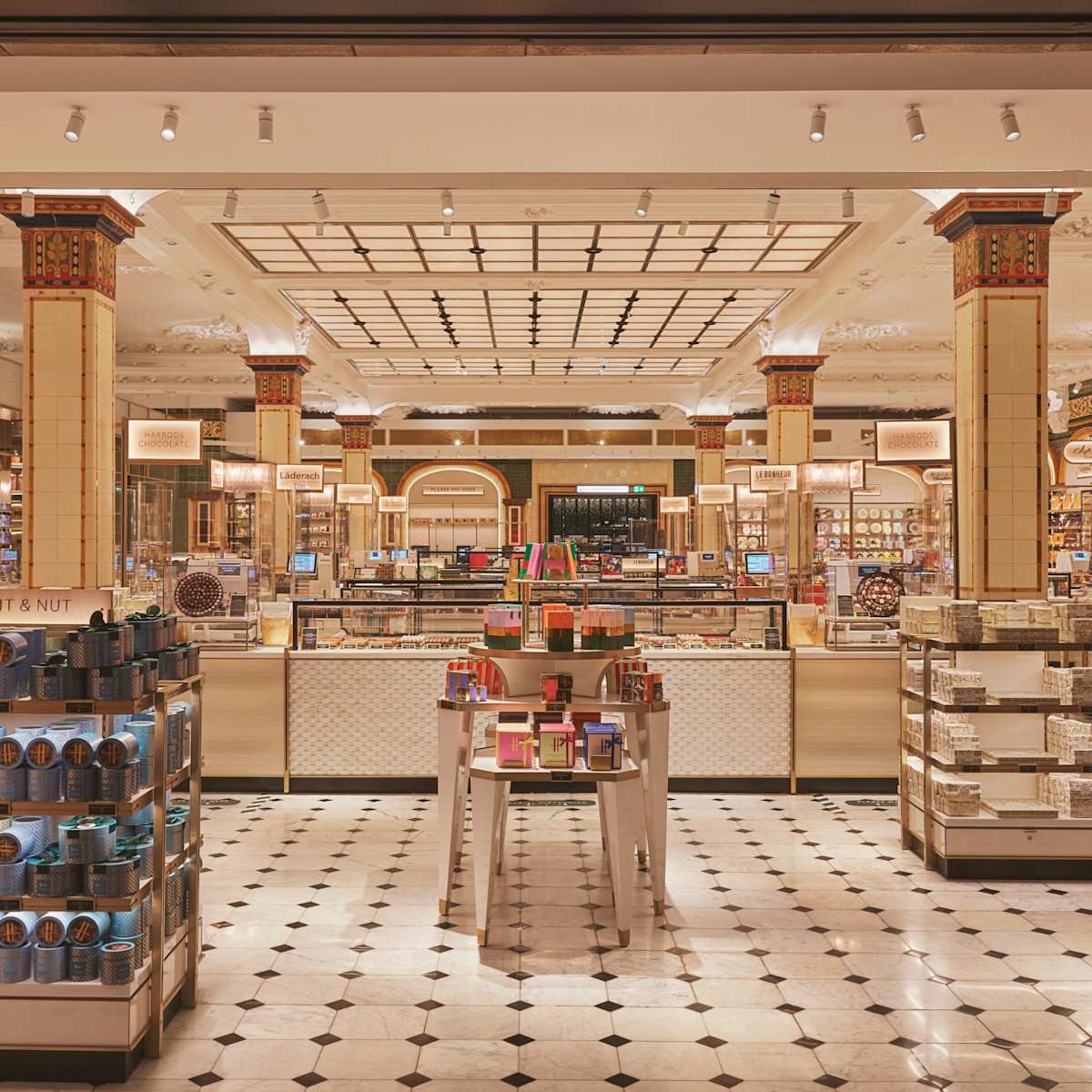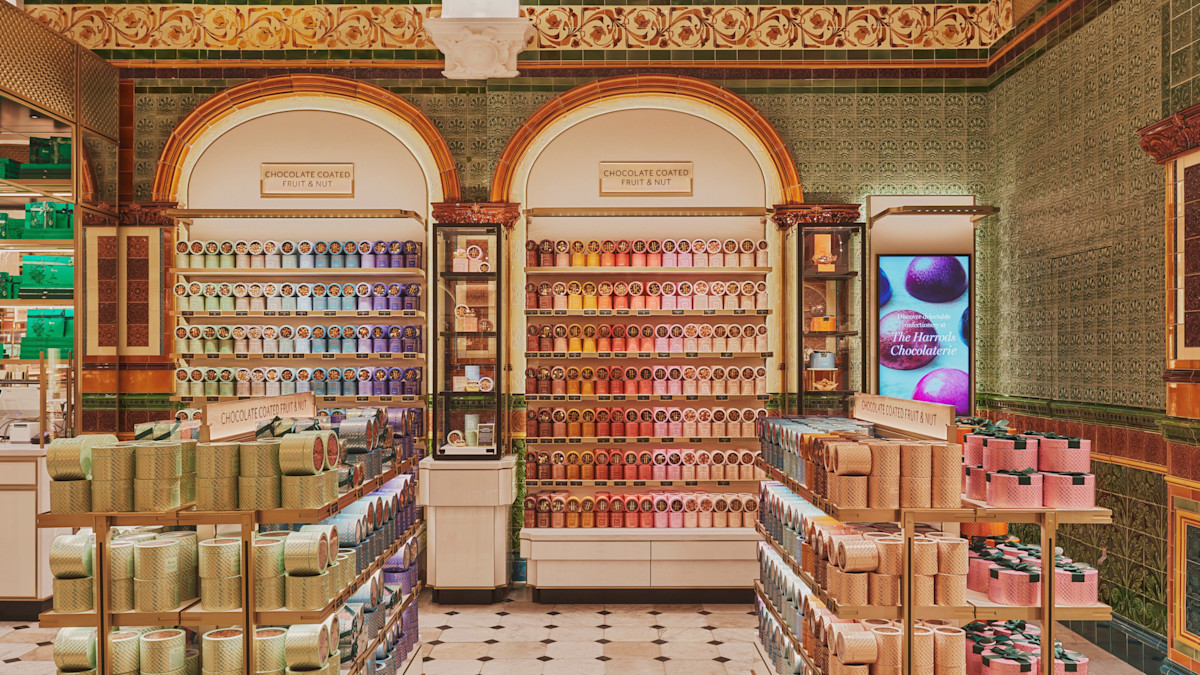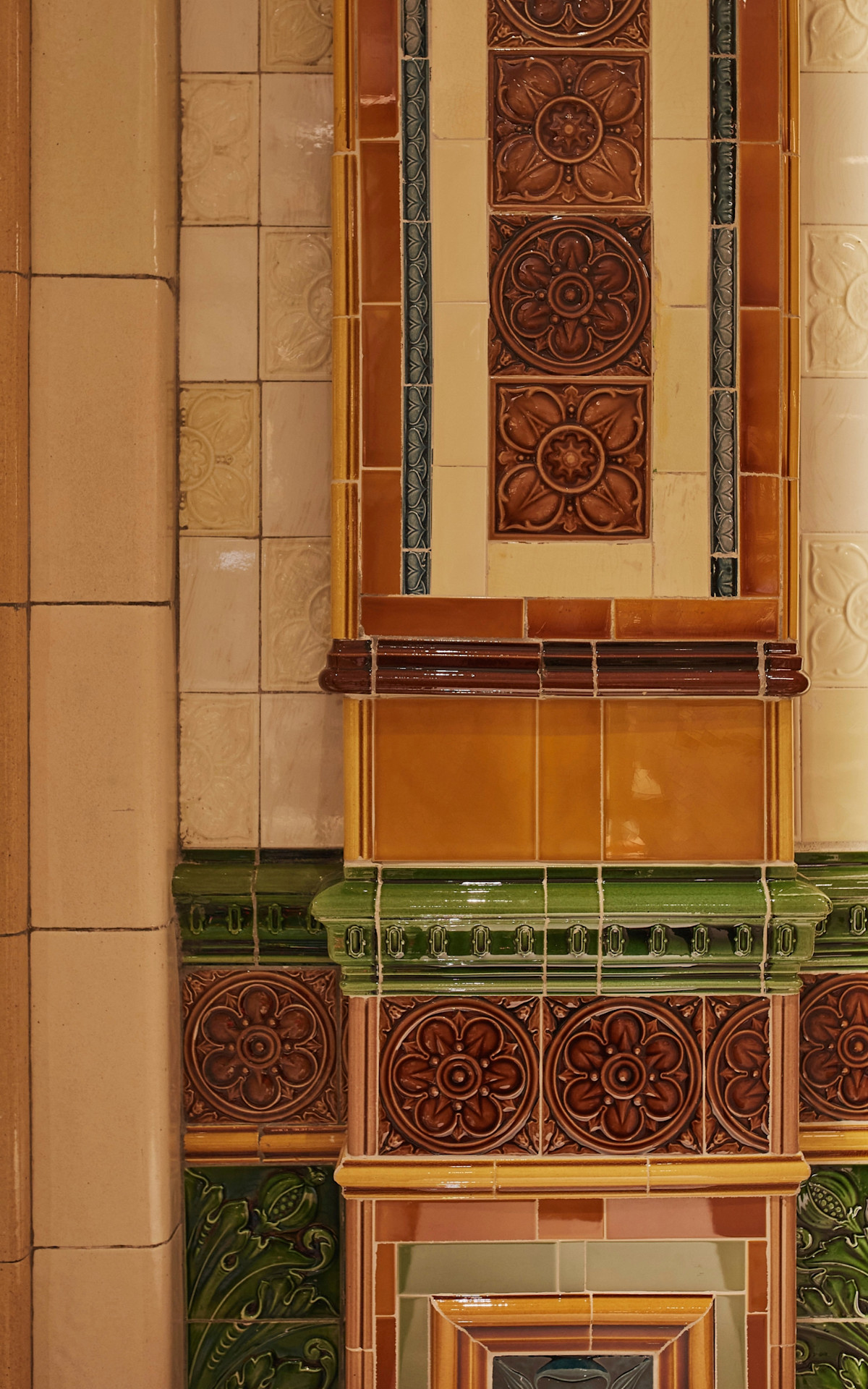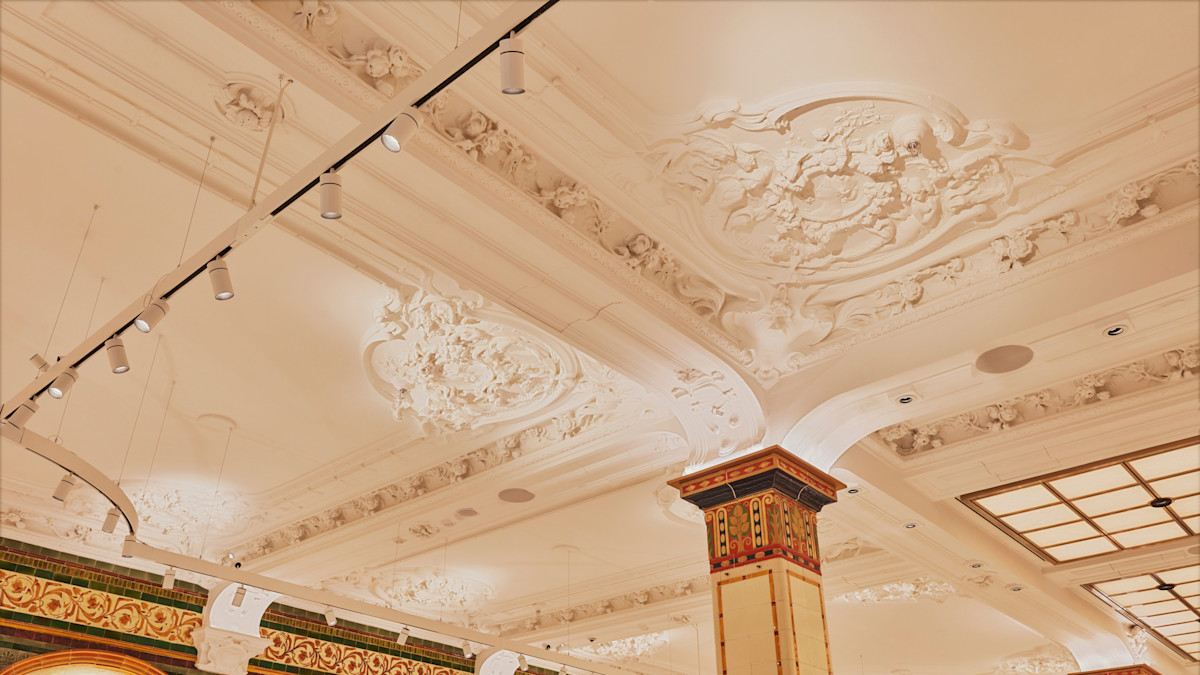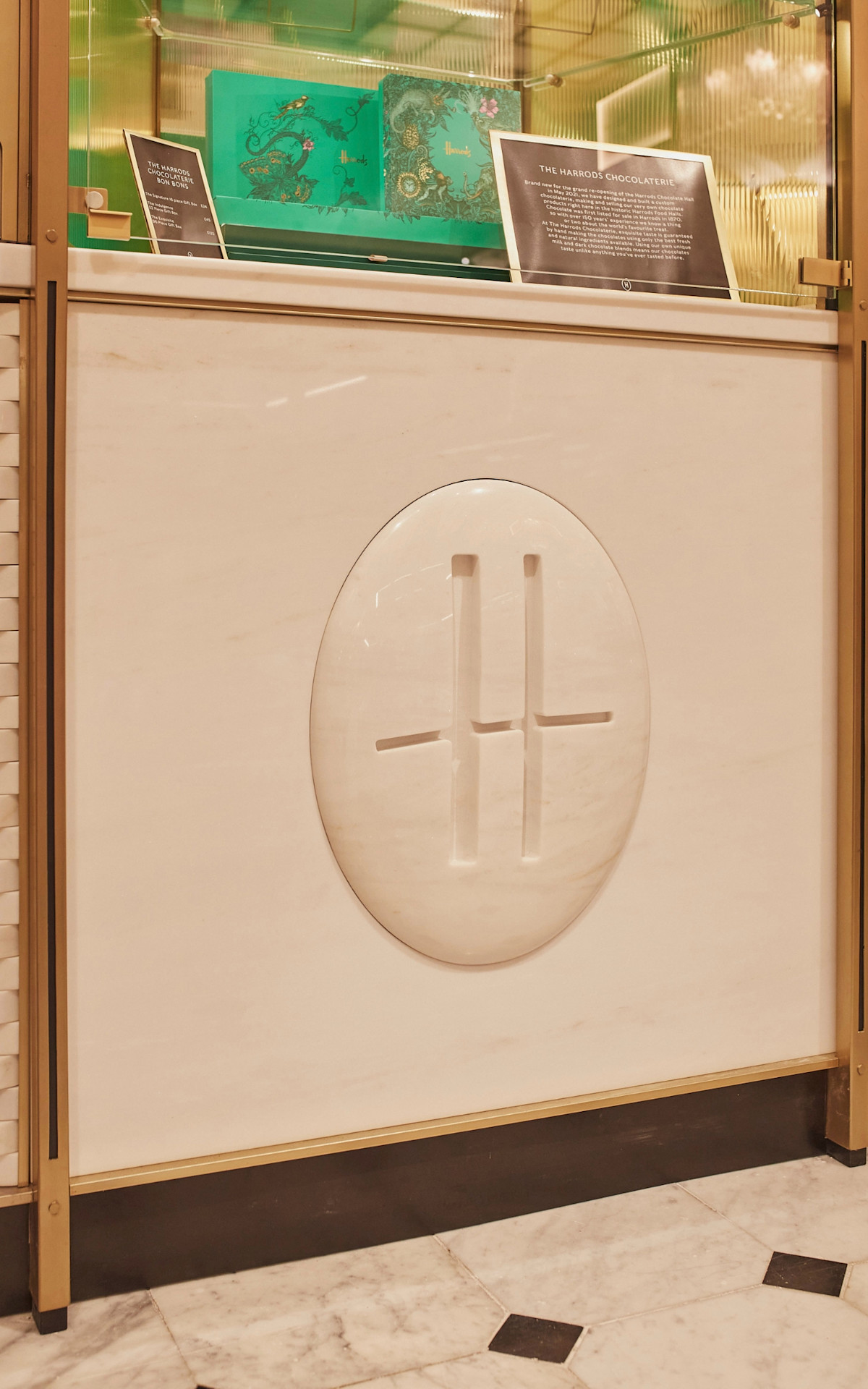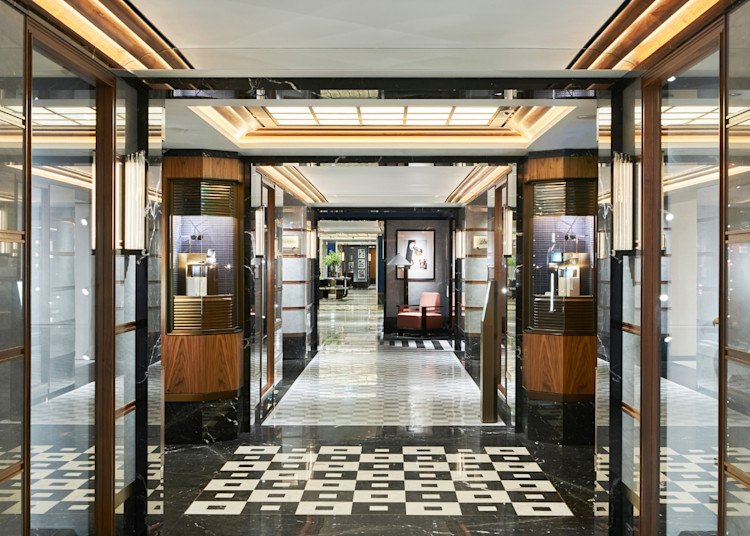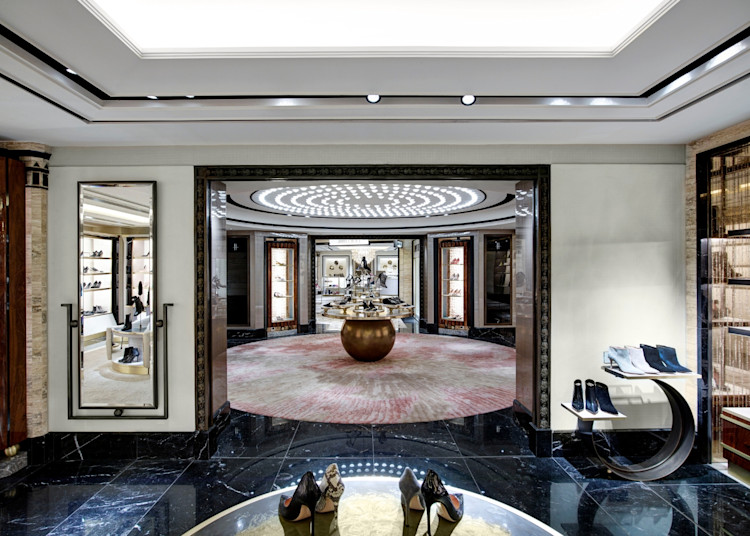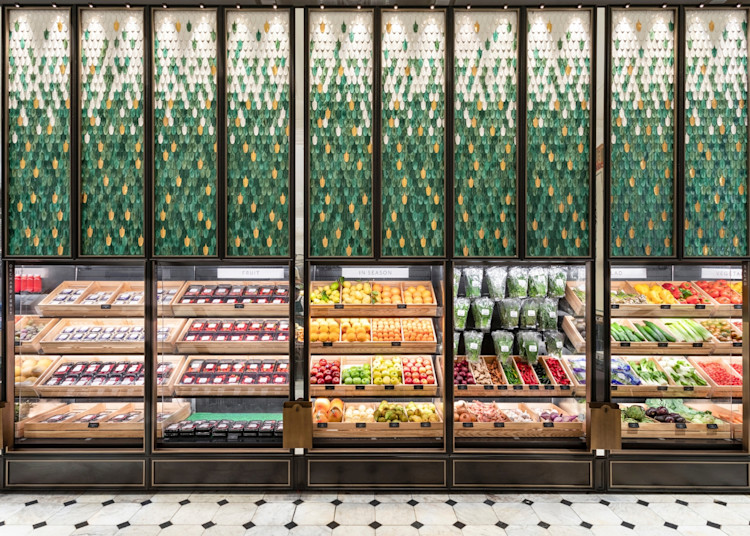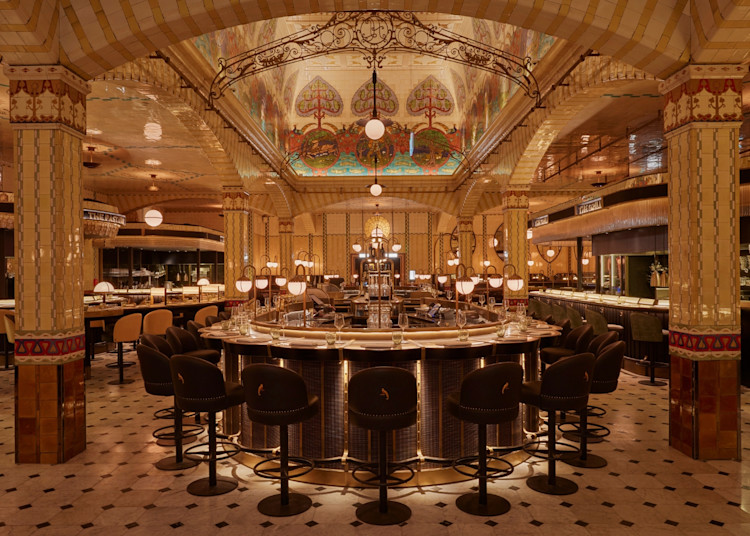London, 2021
Harrods Chocolate Hall
Harrods' Chocolate Hall reimagines the historic space with modern design, showcasing world-renowned chocolatiers in an elegant, temperature-controlled environment, complete with a live Chocolaterie and bespoke displays.
The Chocolate Hall is the fourth and final of Harrods’ food halls to be treated to a makeover by London-based David Collins Studio. Each room has it particular pleasures: espresso martinis, bespoke blends of tea and a bell announcing a fresh batch of croissants in The Roastery and Bake Hall; sausage rolls and Stilton and steak pies to heat at home in the Fresh Market Hall; and the most famous chefs in the country in the Dining Hall, where Vineet Bhatia’s Kama grills some of the best lamb chops in London.
Ben McCormack, Robb Report
Our vision for The Chocolate hall was to take the original ark tiled room and offset it with graphic neutral layers which would form a refined and luxurious backdrop to a product which can look busy. This neutral palette was formed form shimmering, textured, crafted materials, which beautifully harmonise with the chocolates, and their packaging, and pops of brass and black outline and highlight for dramatic effect.
Simon Rawlings, Chief Creative Officer, David Collins Studio
While the chocolate factory might be steeped in history, the new Hall is designed with the modern shop-goer in mind. The interiors have been designed by the illustrious David Collins Studios, who undertook an exhausting restoration process of the original chocolate hall which included reworking the space's extensive tilework by hand and recreating the impressive granite and marble floor.
Mary Cleary, Wallpaper*
“I’ve wanted to design food retail my whole career,” admits Simon Rawlings, creative director of David Collins Studio. It might come as a surprise that a firm that has created stores for jewellers David Morris and De Grisogono and fashion brands Jimmy Choo and Alexander McQueen – to say nothing of creating the timeless look of such restaurant icons as The Wolseley and Cecconi’s – waited so long to enter the world of high-end food shopping. But if David Collins Studio is going to commit to a project, it will only ever be the very best.
The Studio has just unveiled the Chocolate Hall at Harrods, the fourth and final of the legendary store’s world-famous Edwardian food halls to be restored and renewed. The Chocolate Hall is the icing on the cake of a £300m investment plan to refurbish much of Harrods’ 1 million sq ft Knightsbridge site.
“When we started designing the four food halls, we understood how we wanted each to be different and how they all had to work together,” Rawlings explains. “We knew that the Roastery and Bake Hall would be a little bit more earthy and the materials a bit darker. The Fresh Market Hall came next, which we wanted to be 100 per cent focused on product. The Dining Hall was about creating an evocative respite from the rest of the shop. And the Chocolate Hall was envisaged as a big, bright space that balanced the importance of the displays with a glamorous, holistic environment.”
Each hall presented its specific demands but the Chocolate Hall posed the greatest challenge of all. “The other halls were quite pared back in their areas of detail,” Rawling says, “whereas the Chocolate Hall was a mass of colour and pattern everywhere. And the product itself can look very untidy because there are lots of bright colours and little boxes and brown squares. Ultimately, we had to do something that would frame the product while not blocking the existing elevations that Historic England want to see.”
The best way to get a sense of the 5,000 sq ft room is to descend the staircase from womenswear. The light, bright space that opens up below feels more like the Beauty Halls (another department with lots of small boxes) than the Food Halls. Look up, and the central viewing gallery from the room’s time as Harrods’ palm-tree department has been replaced with a backlit ceiling which illuminates each of the 11 concessions below.
The brands on offer represent a curated showcase of the world’s foremost chocolate makers. Harrods is the only place in the UK where you can buy To’ak from Ecuador (manufacturer of the world’s most expensive chocolate) as well as being the first location outside France to sell the cult pralines of Le Bonheur. There are also small-batch British producers such as Pump Street Chocolate from Suffolk (which also happens to be owned by Rawlings’ wife Joanna Brennan) and Harrods’ own-label Gold Bars and fruit and nut boxes.
It might sound like a sensory overload, but the small scale of each concession makes browsing easy, whether you’re exploring everything that’s on offer (ideally while nibbling on a strawberry freshly dipped in melted Godiva chocolate) or making a beeline for your favourite brand. “We spent a lot of time looking through the Harrods historic archives to understand how counters looked in the past. But we’ve ensured that the detailing is very crisp and very contemporary.”
Crisp and contemporary it may be, but there’s no escaping the weight of history in the Grade II*-listed room. Harrods has been selling chocolate for 150 years and producing it onsite since the early 20th century. The Chocolate Hall, however, is very much a 21st-century shop in which to buy things, rather than a museum in which to admire them. “There’s a fine line between restoring something beautifully, or taking it too far so it just looks new,” Rawlings says. “I feel that if you restore to the point where a room becomes overly pristine, it loses the fact that it’s had a past life, a past history. What we’re doing is giving it a new lease of life, which is part and parcel of that history.”
That has included restoring 80 different types of tile in partnership with specialist conservation architects Craven Dunhill Jackfield, and entirely remaking the tiles by hand where necessary. The sweeping staircase, meanwhile, has been French polished back to its original Edwardian gloss.
But the tiles and staircase are only half the story. “One of the most challenging things is that the whole room has to be a specific temperature, in order for the chocolate not to bloom,” Rawlings says. “There are two big insertions in the ceiling, which provide extra cooling for the space and which we haven’t tried to disguise. Instead, we have tried to make them feel quite separate to the historic architecture to show how the space had evolved.”
The most dramatic insertion of all is the Chocolaterie, an open kitchen where Harrods’ 22-strong brigade of pastry chefs apply their craft at a gleaming metal counter in front of customer’s eyes. Rawlings knew from seeing customers watching batches of Harrods’ signature blend coffee being produced in the Roastery and Bake Hall, or the butchers and fishmongers at work in the Fresh Market Hall, that sales increase when shoppers have the opportunity to interact with experts who can tell the story behind the product and bring the retail experience to life.
“The idea behind the Chocolaterie was to bring in a focal point to the room and a visual draw to communicate the message that things are being produced in store,” Rawlings says. “Retailers are always looking for theatre within the shopping experience, so not only does the Chocolaterie help keep people in the room, it will hopefully bring in customers who are not necessarily chocolate lovers to have a look and experience something new as well.”
Of course, all of the Chocolate Hall’s customers are experiencing something new when they step into the refurbished space for the first time. Yet in time, the new-look food halls will become as familiar a part of Harrods’ visual identity as the 12,000 light bulbs that illuminate the store’s exterior by night.
“I recently did a talk to the Harrods team,” Rawlings says, “and one of the audience stood up and asked, how does it feel that you’re making a mark on something of such historical importance, and that what you have created will now become part of that history? I’d never thought about it like that. But since then, I felt a lot more pressure for it to really succeed.”
The food halls, Rawlings says, have been a highlight of his career. The proof is in the pudding. A chocolate one, naturally.
Written by Ben McCormack
Photography by Kensington Leverne
Press
Wallpaper*
New Harrods Chocolate Hall is steeped in history
Hypebeast
Harrods May Have Opened the World's Greatest Chocolate Hall
Robb Report
Willy Wonka Who? Harrods Built a Chocolate Lover’s Paradise With Its $421 Million Renovation
The Telegraph
First look inside the UK's most over the top chocolate store, where a single bar costs £350
Related projects
Harrods Mens' Superbrands, London
Retail
Harrods Shoe Heaven, London
Retail
Harrods Fresh Market Hall, London
Retail
Harrods Dining Hall, London
Retail
